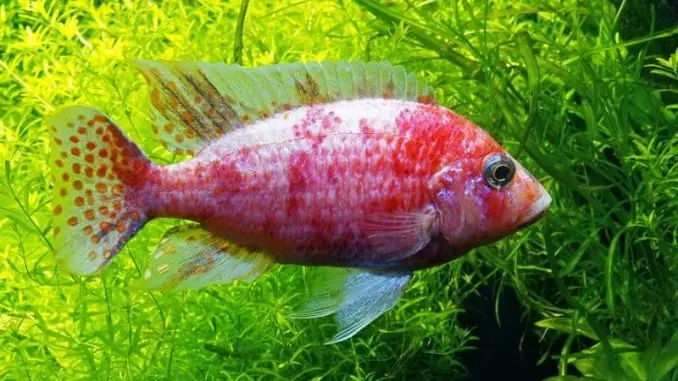
The strawberry peacock cichlid is a brightly colored freshwater fish from the south of Lake Malawi. It is part of the Cichlidae family and is a favorite amongst aquarists.
Strawberry peacock cichlids have bright pink and red colors with dot patterns, and the males are brighter than the females.
Although strawberry peacock cichlids are classified as semi-aggressive, the fish are calm most of the time. These cichlids are popular due to their colorful appearance.
TABLE OF CONTENTS
Strawberry Peacock Cichlid Facts & Overview
| Scientific name: | Aulonocara species hybrid |
| Common names: | strawberry peacock cichild, peacock cichlid, strawberry sunburst cichlid |
| Distribution: | South of Lake Malawi |
| Size: | 4–7 inches |
| Life expectancy: | 6–8 years |
| Color: | Bright pink, red, blue, yellow |
| Diet: | Omnivore |
| Temperament: | Semi-aggressive |
| Minimum tank size: | 55 gallons |
| Temperature: | 74–82°F (23–28°C) |
| pH: | 7.5–8.5 pH |
| Hardness: | 4–6 dH and 10–15 dKH |
| Care level: | Moderate |
| Breeding: | Egg-scatterer |
Origin
The strawberry peacock cichlid (Aulonocara species hybrid) is from the southern side of Lake Malawi in eastern Africa.
Strawberry peacock cichlids swim near the sand underneath the water, where the fish find food. These cichlids are popular fish for aquariums, but they are rarer than some other breeds of fish.
Adult Size and Lifespan
The female strawberry peacock cichlid is smaller than the male, at about 4 inches. The male, when fully grown, can reach 6 inches or larger.
This fish lives for between 6 and 8 years. It takes 2 or 3 years before strawberry peacock cichlids reach their full size, so adjust tank size accordingly when raising the fish from young.
Availability
It can be challenging to find strawberry peacock cichlids to purchase because of how rare the fish are. However, the fish are sometimes available at The Fish Store or on eBay.
Strawberry peacock cichlids cost around $20 per fish.
Appearance and Behavior
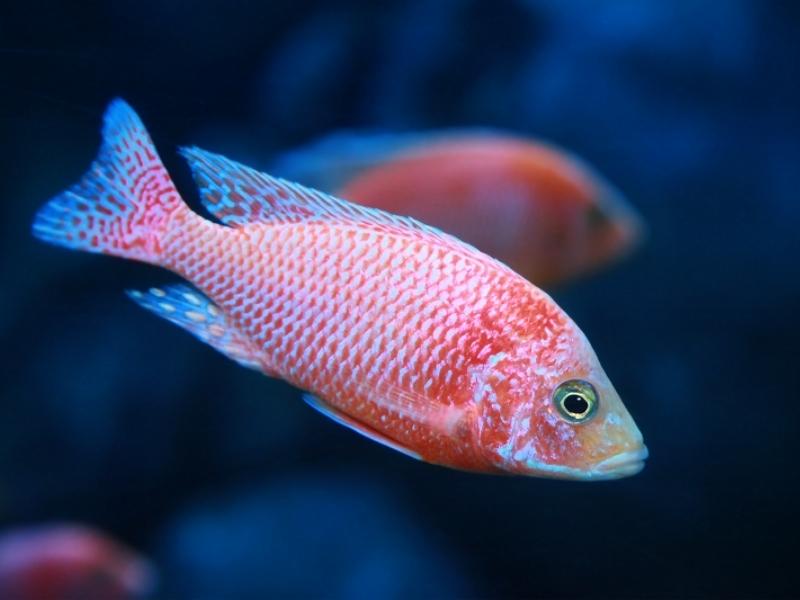
The strawberry peacock cichlid is noticed for its bright pink colors, which are more prominent in males than females.
Females are more muted in color compared to males. Male and female strawberry peacock cichlids have dots on their fins.
The color of a strawberry peacock cichlid can change in the light. When a strawberry peacock cichlid is experiencing stress, its color will change to white.
Typical Behavior
Although the strawberry peacock cichlid isn’t known for being aggressive, the male fish can become competitive and eat smaller fish.
Strawberry peacock cichlids are classified as semi-aggressive, but the proper ratio of males to females can help prevent conflict. One male to every four females is best.
Strawberry peacock cichlids are territorial, so the fish must have space. Otherwise, aggressive cichlids may chase and bite one another. Biting or nipping also occurs if the fish are showing off.
To reduce aggression, add more plants and caves to the tank to create mini territories and make the environment less threatening for the fish. As a last resort, remove the aggressor.
In the wild, strawberry peacock cichlids swim near the bottom of the water, and the fish are bottom-dwellers in aquariums, too. They are active, preferring warm water and lots of swimming room.
Strawberry peacock cichlids favor lots of caves and places to hide, and are more active during the day than at night.
Strawberry Peacock Cichlid Care
Beginners and experienced aquarists should find strawberry peacock cichlids easy to take care of.
Disease
Some of the diseases to look for in strawberry peacock cichlids are:
- Malawi bloat: A fish with Malawi bloat won’t eat and will spend most of its time at the bottom of the aquarium. Additional symptoms are swelling of the stomach and breathing difficulty. To treat Malawi bloat, switch 40% of the water in the tank and feed your fish food with Metronidazole, or add 50 mg of Metronidazole per gallon of water.
- Swim bladder disease: If a strawberry peacock cichlid stays at the top of the tank and floats, it may be affected by swim bladder disease. To treat the disease, improve the diet of your fish. Make sure the fish gets enough fiber and has a healthy diet.
- Tuberculosis: A severe disease that can affect your strawberry peacock cichlid is tuberculosis. This disease is contagious and can be passed to humans if the person has an open wound. A fish with tuberculosis has a sunken stomach, frayed fins, and white blotches on its body. The fish may also stop eating. If you notice these symptoms, remove all other inhabitants from the aquarium and disinfect the tank containing the diseased fish and the tank containing the other fish.
Keep a close eye on the fish in your tank, and keep track of symptoms or behaviors that are out of the ordinary. Checking up on your fish helps prevent disease and supports a healthy tank environment.
Habitat and Tank Requirements
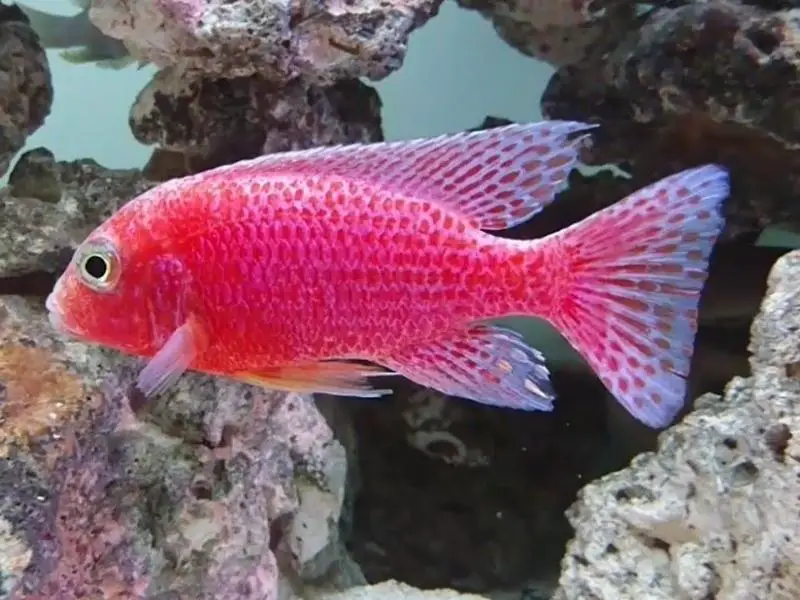
| Water type: | Freshwater |
| Tank size: | 55 gallons |
| Water temperature: | 74–82°F (23–28°C) |
| Substrate: | Fine, sandy substrate |
| Tank setup: | Hiding areas with plants, driftwood, and rocky caves |
| Acidity: | 7.5–8.5 pH |
| Water hardness: | 4–6 dH and 10–15 dKH |
| Filter: | Yes, up to a moderate current |
| Bubbler: | Yes, unless in a tank with oxygen-rich plants |
| Lid: | Not necessary |
Strawberry peacock cichlids like to swim around and have high activity needs, requiring plenty of swimming space. This territorial fish species enjoys hiding in rocks, caves, and plants.
Tank Conditions
Strawberry peacock cichlids require clean freshwater with a consistent temperature. The water’s pH should be 7.5–8.5 and the temperature between 74 and 82°F.
Strawberry peacock cichlids need a large aquarium of at least 55 gallons.
The water temperature should be like the fish’s natural habitat, as this is the environment that the cichlids are used to.
Find deep-rooted plants that these cichlids can’t dig up out of the bottom of the aquarium, such as hornwort, Java moss, and anacharis.
Use sand for the bottom of the aquarium instead of gravel, which can damage the strawberry peacock cichlid’s gills.
Tank Mates
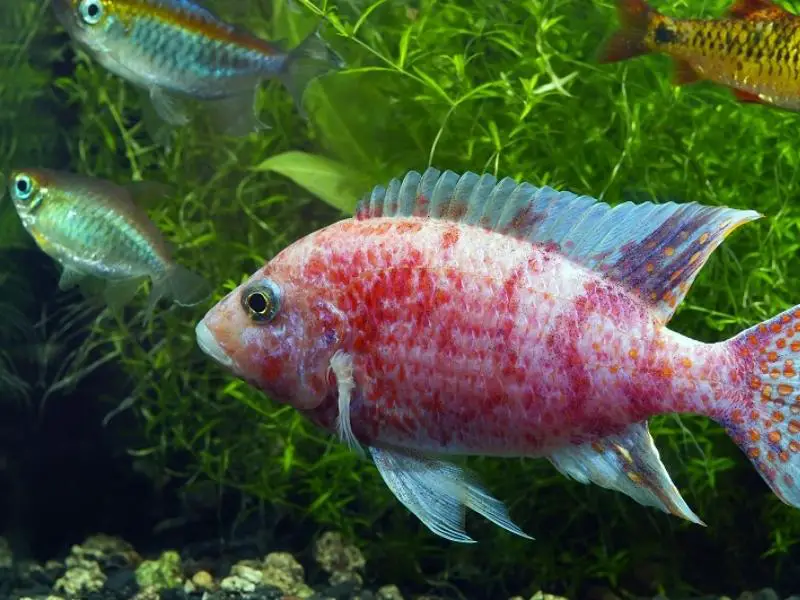
The best tank mates for strawberry peacock cichlids are non-aggressive fish that live in the same environment as the cichlids.
Strawberry peacock cichlids can live with other fish of their kind as long as there are more females than males.
Other fish that are likely to do well with this breed are peaceful cichlid species like the haplochromis cichlid.
Here are some other suitable tank mates for strawberry peacock cichlids:
- Redtail shark
- Pleos
- Placidochromis
- Copadichromis
- Rainbow shark
- Synodontis catfish
- Nyassachromis
- Sciaenochromis
Shrimp and crabs aren’t good tank mates for strawberry peacock cichlids, because the fish will eat these tank mates.
Diet and Feeding
The strawberry peacock cichlid is an omnivore. The fish finds food by looking through the sand at the bottom of the water, so choosing sinking foods like live food and sinking pellets is important.
In the wild, strawberry peacock cichlids eat insects, larvae, crustaceans, and zooplankton. They also eat vegetables such as boiled broccoli, lettuce, and corn.
Avoid feeding your strawberry peacock cichlid bloodworms, beef heart and tubifex, which are unhealthy for the fish.
In order to keep the strawberry peacock cichlid’s diet as natural and varied as possible in the tank, feed these fish several times a day in small quantities.
Breeding
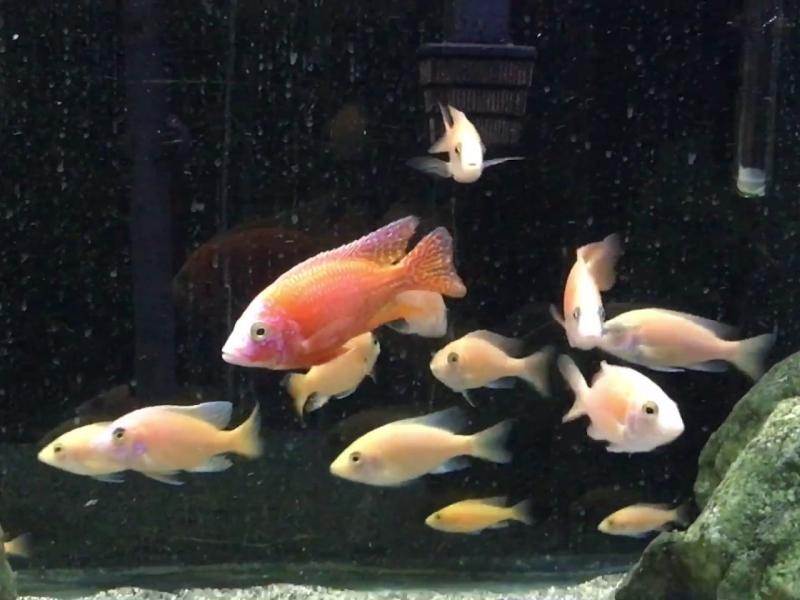
Because male strawberry peacock cichlids are territorial, ensure that the males have their own space and are not near each other during breeding.
In order to breed strawberry peacock cichlids, gradually turn up the tank’s temperature to 82°F. In the warmer water, the male fish will perform darting movements for the female to show his interest.
If the breeding is successful, the female lays the eggs for the male to fertilize. Afterward, the female collects the fertilized eggs in her mouth and tends to them for nearly a month until the fry are born.
Should You Get a Strawberry Peacock Cichlid for Your Aquarium?
If you have the time to focus on raising and learning about a strawberry peacock cichlid, then this fish is suitable for you.
Strawberry peacock cichlids are colorful, fascinating to watch, and full of energy, which makes them rewarding to care for.
However, this breed isn’t the easiest choice for beginners because of the fish’s aggressive nature. If you already have a tank of fish and some are aggressive species, you should keep the strawberry peacock cichlids in another tank or not get the fish at all to avoid conflict in the tank.
The strawberry peacock cichlid is a good addition to an aquarium, provided you have the knowledge or are willing to learn about the fish.

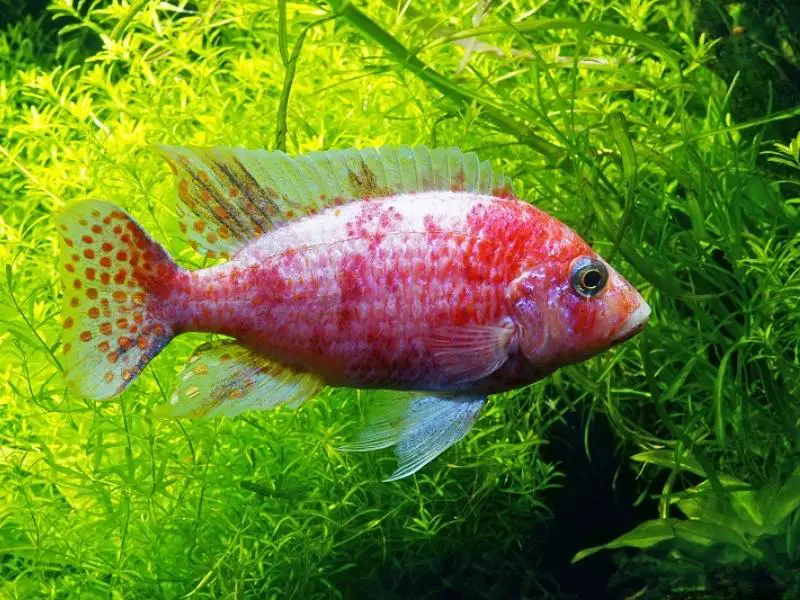
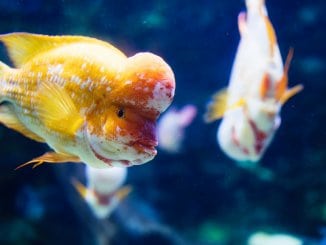
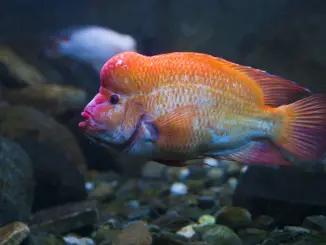
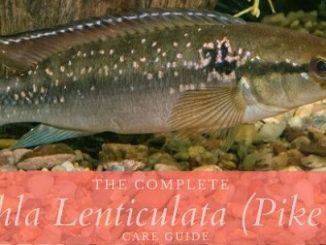

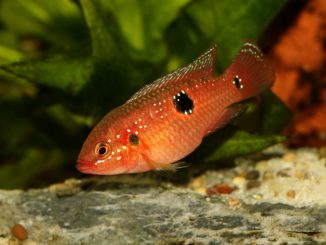
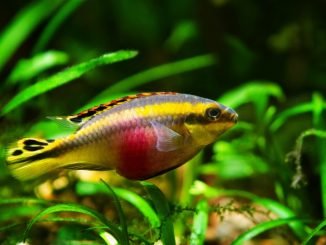
Be the first to comment